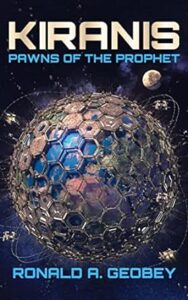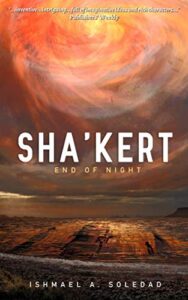Kiranis: Pawns of the Prophet (KIranis #2) by Ronald A. Geobey
Temple Dark Books, 2022
ISBN: 9781838259464
Available: Paperback, Ebook
Buy: Amazon.com
The saga continues…
The second volume in the Kiranis series, Pawns of the Prophet contains all of the elements that made Gods of Kiranis a breathtaking (or maddening) tale, depending on perspective. If you enjoyed the first book, there’s nothing in this one to dissuade readers from continuing the journey through one of the most unique sci-fi sagas ever written. New readers: you must read the first one before the second: you’ll be utterly lost, otherwise.
The story takes place 100 years after the first book, but ties into those events, and the scale of the story has widened further into the galaxy. Once again, it’s incredibly well written, with a multi-layered, extremely complex plotline. It’s split into large sections, each focusing on a particular group, but unlike last time, the parts run in a more linear fashion.
Enjoying the book will depend greatly on the reader, and HOW you approach it. There are some readers who will breeze through this and comprehend all the details and plot tie-ins with one shot, but they will probably be the minority, you’d almost have to have an eidetic memory. There is no fluff or filler, everything is written with a purpose, with items that show up halfway through the 400+ pages relating all the way back to the prologue. The details are important, but they are often quite spread out in how they relate to each other. That’s what makes this book a little tricky to read.
My personal approach? I’m a reader that likes to understand all the story links in the chain, I want to know how A connects to B, to C, all the way to the end. So, I read a few chapters, then read them again and took notes on what I considered important. No joke- I ended with 20 pages of notes, plus a list of characters with rough descriptions, it ran over sixty characters. It was a lot of extra time, but it helped immensely with connecting the plot points, I used my notes often for story comprehension. As a result, for me the story all made sense from beginning to end. Most readers probably won’t need to do this, but that’s what it took for me to fully enjoy the book, and it was well worth the extra time. This just helps to illustrate how intricate the plot is
.
Don’t let the above scare you away-there are plenty of readers who will read this for pure enjoyment, zip through and enjoy it to the end, although they might not know exactly how they got to the end, or what just happened. Fully grasping the author’s vision will likely take more time and thinking then it would for most books.
Bottom line: highly recommended: there really isn’t anything out there like this, and the journey’s barely begun, since there are supposed to be at least 4 more volumes. Do yourself a favor and take a chance on the series: epics like this are rare and deserve a look.
Recommended, highly so for lovers of elaborate stories.
Reviewed by Murray Samuelson






Follow Us!